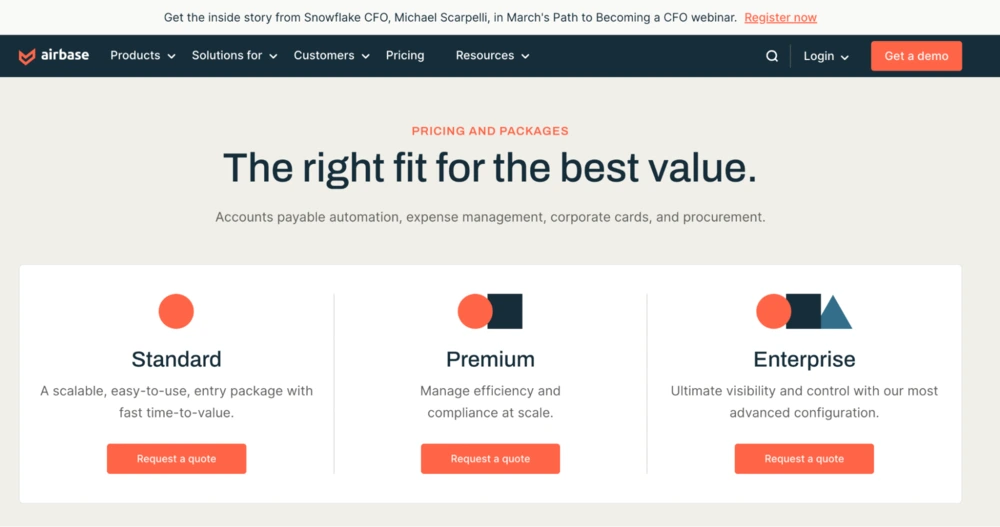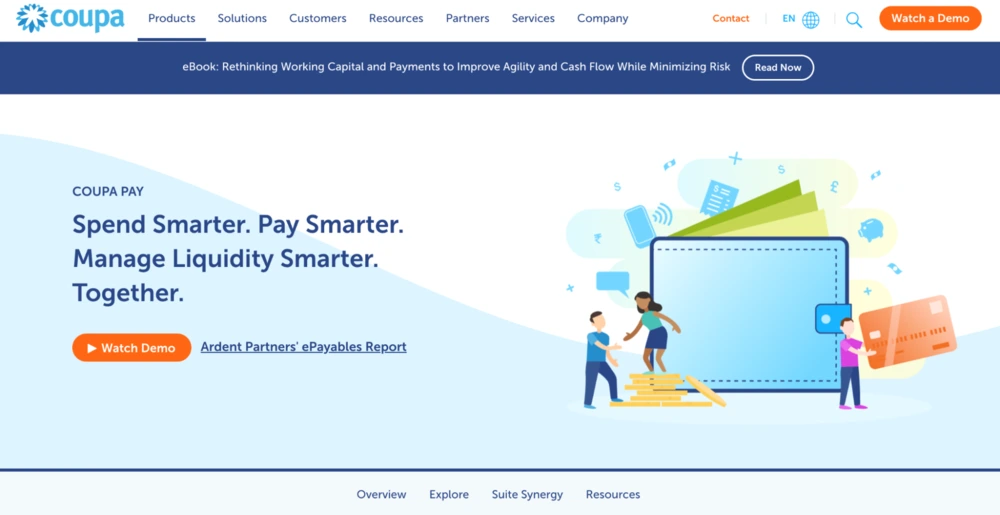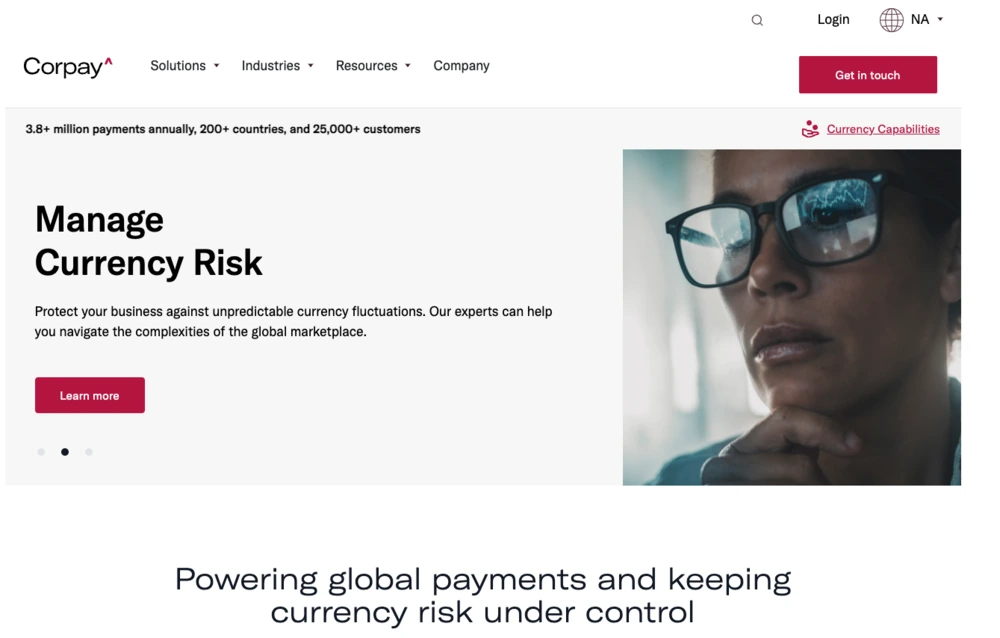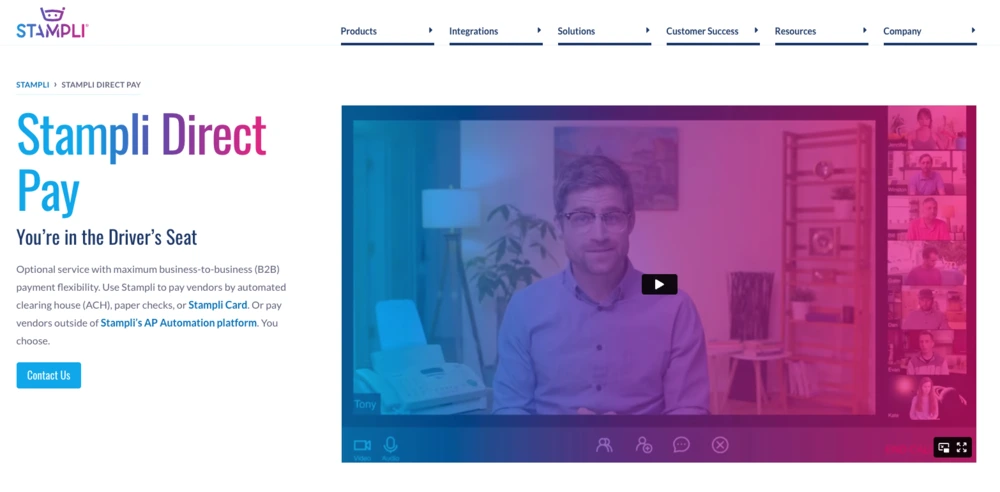Last Updated on November 28, 2025
Enterprise payment software
Managing payments globally is like conducting an orchestra with several musical instruments.
Just like musicians play the instruments harmoniously to create melodious music, enterprise payment software uses multiple currencies, cross-border payment methods, and regulations in sync to ensure smooth and efficient transactions.
Enterprise payments software does everything from managing finances to streamlining payment processes for fast-paced and globalized businesses. Efficient payment systems are no longer a luxury but a necessity. However, choosing the right software for payments can be tricky, with many available options, can be tricky.
In this article, we dive deep into enterprise payment software, exploring the benefits, features, and factors to consider when selecting the perfect solution for your business.
What is enterprise payment software?
Enterprise payment software automates and streamlines your payment operations, saving time and reducing errors. It provides features such as payment processing, invoice management, payment tracking, and reporting.
Enterprises use payment software to increase payment processing efficiency, automate many transactions, reduce errors, and prevent fraud. Accountants leverage payment software capabilities for bank reconciliation and processing payments from multiple mediums like retail and E-Commerce.
It’s best to integrate payment software with accounting systems. It helps you comply with industry regulations such as Generally Accepted Accounting Principles (GAAP) in the US or International Financial Reporting Standards (IFRS) elsewhere.
Also, Read: 10 Best Expense Management Software
List of top 6 enterprise payment software
An in-depth comparison of the top 6 enterprise payment software
1. Airbase
Airbase is an enterprise payment software that streamlines and simplifies the often-complex payment process in a business environment. By combining robust functionality with intuitive, user-friendly design, Airbase empowers businesses to manage their payments with greater efficiency, accuracy, and control.
With Airbase, businesses can easily track expenses, streamline approval workflows, and make payments quickly and securely.

Top features of Airbase
Airbase offers a range of powerful features designed to simplify the payment process and improve financial management for businesses.
Here are some top features of their enterprise payment software:
- Automated invoice processing: Airbase uses OCR technology to automatically extract information from invoices, making it easy to review, approve, and pay bills.
- Customizable approval workflows: Airbase allows businesses to set up customized approval workflows, ensuring that all expenses are properly reviewed and approved before payment is made.
- Real-time financial reporting: Airbase provides real-time financial reporting, allowing businesses to track expenses, monitor budgets, and generate reports with ease.
- Advanced spend controls: Airbase offers a range of spend controls, including spending limits, category restrictions, and time-based controls, giving businesses greater control over their expenses.
- Seamless integrations: Airbase integrates seamlessly with popular accounting software, such as QuickBooks, Xero, and NetSuite, making it easy to sync data and streamline financial management.
Pricing
Airbase offers three plans for its users, namely: Standard, Premium, and Enterprise. The company hasn’t disclosed the pricing on its website. They encourage potential buyers to request a quote to provide customized pricing based on their requirements and business needs.
Pros and cons of Airbase
Pros |
Cons |
|
Transactions show up immediately without any delays |
Not the best tools for those with inconsistent spending. (G2) |
|
Easy to adopt and integrate |
Issues on getting SSO integration up and running (G2) |
|
Easy to adopt and integrate |
– |
Suggested Read: 11 Best Billing Software in India
2. Stripe
Stripe’s payments software provides a platform for businesses to accept payments and move money globally, all while capturing more revenue. Stripe offers a complete stack of payment solutions for all types of businesses, from e-commerce stores to subscription businesses, platforms, and marketplaces.
Stripe offers flexible integration options to simplify PCI compliance without compromising the customer experience during checkout. Businesses can use Stripe Checkout, a hosted payment page that dynamically adapts to the customer’s device and location, increasing conversion.

Top features of Stripe
Below are some popular features of Stripe.
- Flexible invoicing: Allows businesses to customize invoices for one-off or recurring payments.
- Integrations: Provides integrations with popular accounting software like Xero or Sage and CRMs such as Salesforce, HubSpot, and many other popular platforms.
- Shareable links: It enables you to create payment pages and share links with customers.
- Mobile app: Lets businesses accept payments in Android or iOS applications using mobile software development kits (SDKs).
- AES encryption: It provides a secure way to make payments across the globe.
Pricing
Stripe offers a pay-as-you-go pricing model. It charges 2% for cards issued in India and 3% for cards issued outside India. You can also contact Stripe’s team to check out their enterprise plan that comes with account management, migration assistance, and dedicated support.
Check out their pricing page for more details.
Pros and cons of Stripe
Pros |
Cons |
|
Integration with CRM |
Payments can be deposited fast to checking accounts (G2) |
|
Easy to use, and budget-friendly |
Protocol required to create an account(G2) |
|
Provides efficient and secure payment processing |
Currency conversion charges are super high (G2) |
Future Read: 11 Best Online Business Payment Solutions
3. Tipalti
Tipalti enterprise payment software streamlines and simplifies payment processes for growing companies. Tipalti integrates with popular ERP and accounting systems such as Oracle NetSuite, Sage Intacct, QuickBooks, Microsoft Dynamics, and Xero.
The platform serves various industries, including advertising technology, affiliate and influencer networks, business services, e-commerce and retail, healthcare, marketplaces, and the gig economy.

Top features of Tipalti
Below are some popular features of Tipalti.
- Global payments: Provides scalable payment solutions for creators, ad tech, sharing, and marketplace economies.
- AP automation: Enables end-to-end invoice based-payments designed for growing companies.
- PO management: Allows businesses to have control and visibility over corporate spend.
- Cards: Help businesses to easily manage and reconcile spend while receiving cashback.
Pricing
Tipalti offers custom pricing for businesses based on their needs and requirements. You can contact the sales team and book a demo to learn more.
Pros and cons of Tipalti
Pros |
Cons |
|
Effective payment tracking |
Poor reporting capability (G2) |
|
User-friendly platform |
Less customization option (G2) |
|
Robust OCR scanning function |
OCR sometimes requires manual intervention. (G2) |
Quick Read: 10 Best Spend Management Software
4. Coupa
Coupa Pay is an enterprise payments software that enables businesses to banish blind spots and gain complete visibility into their spend, payments, and liquidity, allowing them to make smarter decisions faster. It improves operational efficiency with automated digital payments and touchless invoicing.

Top features of Coupa
Below are some popular features of Coupa.
- Seamless payments: Enables businesses to reconcile and easily manage payments to suppliers, subsidiaries, employees, and other beneficiaries.
- Multilateral netting: Frees cash flow trapped in inter-company payments and improves return on capital.
- Treasury management: Safeguards liquidity with greater transparency into financial ecosystem data across accounts spends, and subsidiaries.
- Risk-aware: Uses community intelligence and other external data to identify high-risk suppliers.
Pricing
Coupa doesn’t provide its pricing plans on the website. They offer custom pricing for users depending on their requirements from the software.
You can get in touch with the Coupa team and learn more about the software’s costs.
Pros and cons of Coupa
Pros |
Cons |
|
The tool is flexible and intuitive |
Difficult to customize employee record form (G2) |
|
User-friendly platform |
The system can be clunky (G2) |
|
Entering PO invoice is easy and saves time |
Significant implementation budget (G2) |
Read More: TOP 7 Coupa Alternatives and Competitors: A Closer Look
5. Corpay Cross-Border
Corpay Cross-Border provides a trading platform that simplifies how businesses connect with global marketplaces. The company offers customized services suited to businesses’ unique requirements, helping them manage currency risks, automate invoices, and power global payments.

Top features of Corpay Cross-Border
Below are some popular features of Corpay Cross-Border
- Integrated payments: It helps ensure effective payment processing by enabling you to create, integrate, service, and scale a currency and payments offering.
- Accounts payables: Streamlines account payables within international subsidiaries with multi-enterprise models.
- Imports: Allows businesses to import payments directly from ERP systems, saving time and resources.
- PayForYou: A service team that submits payments via portals or over the phone on your behalf.
Pricing
Corpay Cross-Border offer a custom payment plan designed for business unique need and requirements. You can get in touch with their sales team to learn more about the software and pricing options.
Pros and cons of Corpay Cross-Border
Pros |
Cons |
|
Lock current currency exchange rates with forward contracts |
Needs alert system for rates (G2) |
|
Easy to create payments and get approvals |
Payment cancellation option is missing (G2) |
|
Platform is intuitive and easy to use |
Doesn’t directly integrate into accounting software (G2) |
Also, Read: 9 Best Vendor Payment Management Software
6. Stampli
Stampli automates accounts payables by combining documentation, communication, corporate cards, and payments in one place. It provides full control over visibility and corporate spending, making it easier to manage finances and reduce errors.
By centering communications on top of the invoice itself, Stampli enables AP departments to collaborate and communicate better with approvers, vendors, and other stakeholders.

Top features of Stampli
Below are some popular features of Stampli.
- Automated clearing house (ACH) reconciliations: Allows your teams to batch-process ACH payments with individual transaction reconciliations in bank statements.
- ACH transactions: Facilitates ACH transactions from your bank account without needing to set up or fund a settlement account.
- Vendor portal: Enables teams to manage vendors easily through portals.
- Paper checks: It empowers you to automatically print and mail physical checks from your bank account using your signature.
Pricing
Stampli offers custom pricing considering the unique needs of teams and businesses. You can contact Stampli’s team to learn more about the product and get a customized price for your requirements.
Pros and cons of Stampli
Pros |
Cons |
|
Robust approval system |
Canadians don’t have a complete product. Invoicing is in USD (G2) |
|
User-friendly interface |
More customization options needed (G2) |
|
Easy to route receivables |
Absence of mobile application (G2) |
Recommended Read: 10 Best Spend Analysis Software
Common features of enterprise payment software
Enterprise payment software helps businesses manage their payments and financial transactions more efficiently. Some standard software features include:
- Payment processing: Allows businesses to process several payment types using various payment methods, such as credit cards, bank transfers, digital wallets, and online payments.
- Payment tracking: Tracks payments and monitors transactions for financial institutions to ensure accuracy and identify potential issues.
- Reporting and analytics: Provide detailed reports and analytics, allowing businesses to analyze their financial data while identifying trends and patterns.
- Security features: Offers robust security features such as data encryption, multi-factor authentication, and fraud detection.
- Integrations: Integrates with other software solutions like accounting software, ERP systems, and CRM systems to streamline business processes and reduce manual data entry.
- Compliance: Helps businesses comply with regulations such as PCI-DSS, GDPR, and other industry-specific regulations.
- Customization: Fits the unique needs of each business by configuring the software to business-specific requirements.
- Customer support: Provides a reliable customer support system to resolve any issues that may arise.
Quick Read: 6 Best Travel & Expense Software
Why do businesses need enterprise payment software?
Enterprise payments software helps large multinational companies streamline payment processing, tracking, and analyzing payment performance at an enterprise level. There are several other reasons why enterprise payments software is an indispensable asset for the CFO’s office.
1. Automate payment processing
Manual payment processing can be prone to errors and consume ample time. With payment software, you can automate invoicing, payment tracking, and reconciliations with workflows to streamline accounts payables and reduce errors caused by manually managing payments on spreadsheets.
2. Consolidate payment data
Payments happen on multiple mediums like retail, E-commerce, and online marketplaces. Enterprise payment tool allows finance teams to consolidate payment data for better tracking.
3. Improve cash flow
Such payment software helps businesses manage cash flow with real-time payment tracking and reporting. This allows teams to predict better and manage cash flow.
4. Enhance security
Enterprise payment platforms comply with security standards to protect sensitive information. They provide high security for payment processing.
Must Read: 6 Best Cash Flow Management Software
What to consider when choosing payment software for enterprises?
Below are the top four aspects businesses should keep in mind while choosing payment software for enterprises:
1. Fees
Businesses usually pay three types of fees, namely: monthly fees, transactional fees, and set-up fees. Some payment solutions charge membership fees, whereas others bill businesses monthly on a pay-as-you-go model. You should plan budgets, depending on the company’s vision and area of business, to avoid overestimating or underestimating their expenses.
2. Currencies
Currency exchange and its fluctuations impact global businesses. Therefore, businesses must look for payment solutions to handle diverse currencies while ensuring seamless transactions worldwide.
3. Recurring billing and integration
When payment software integrates with a business’s existing systems, it can work hand in hand to boost cash flow. An integrated payment software with online invoicing allows businesses to automatically receive payments for recurring bills, which is especially useful for SaaS businesses.
4. Mobile application
Your enterprise payment software should allow consumers to transfer money using their mobile devices, making payments faster and more convenient.
Enterprise payment software – FAQs
An enterprise payment software platform manages and automates payment processes for businesses. It provides a central hub for managing all financial transactions, including accounts payable, accounts receivable, and general ledger management.
An enterprise payment hub integrates with various financial systems, such as enterprise resource planning (ERP) software, accounting systems, and other financial applications, to automate payment processes and minimize manual data entry.
The four main payment methods are cash, credit or debit card, bank transfer, and omnichannel digital payments.
Large businesses use an enterprise payment gateway to process high volumes of transactions. It’s an integrated system to manage all aspects of the payment process, including authorizing transactions, verifying the availability of funds, and settling payments.
A web payment gateway is designed for online merchants who need to accept payments through their websites. The software application processes transactions in real time, allowing customers to pay for goods or services using credit cards, debit cards, or other electronic payment methods. Web payment gateways are often provided by third-party service providers and may be integrated with popular e-commerce platforms such as Shopify, Magento, or WooCommerce.










Discussion about this post